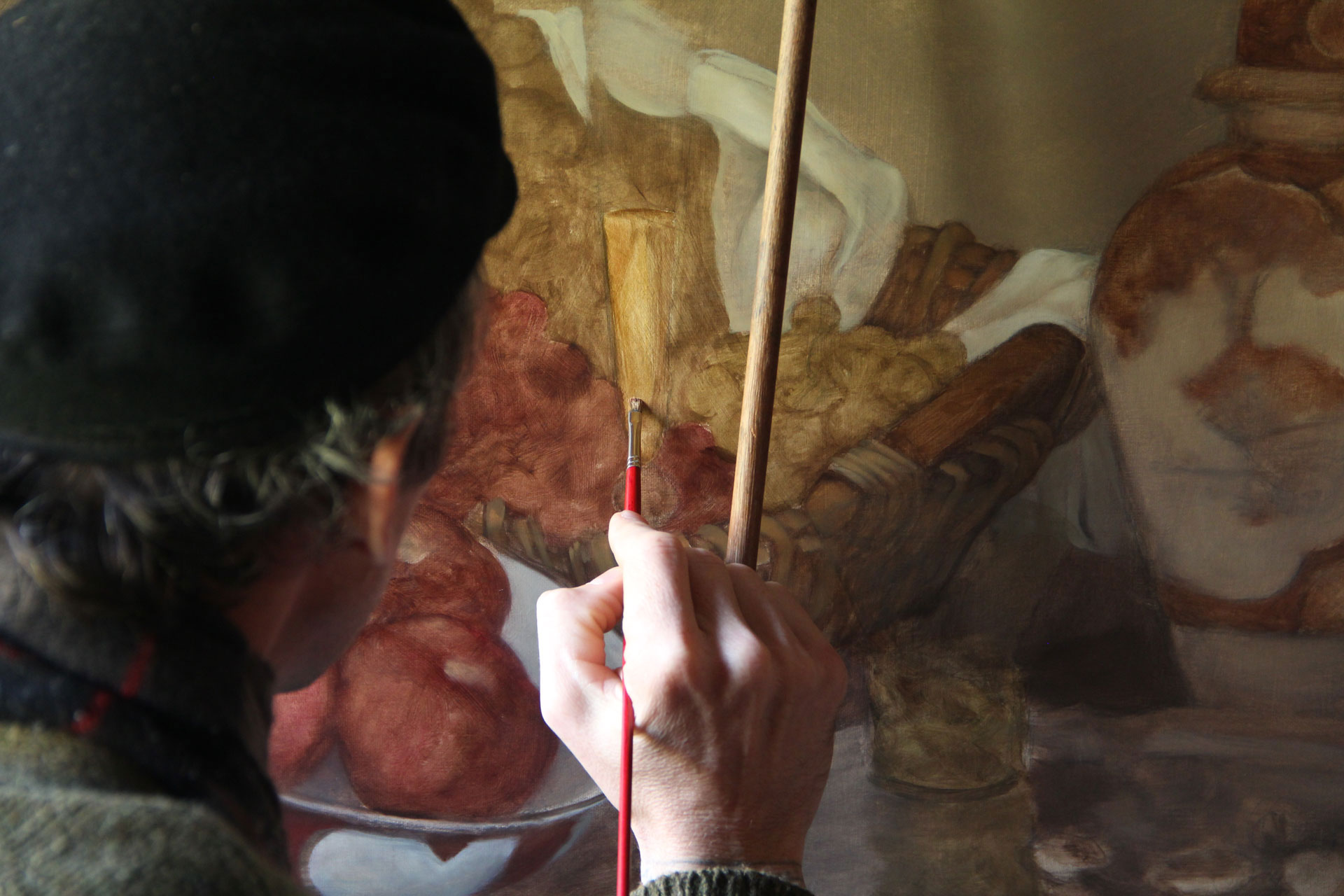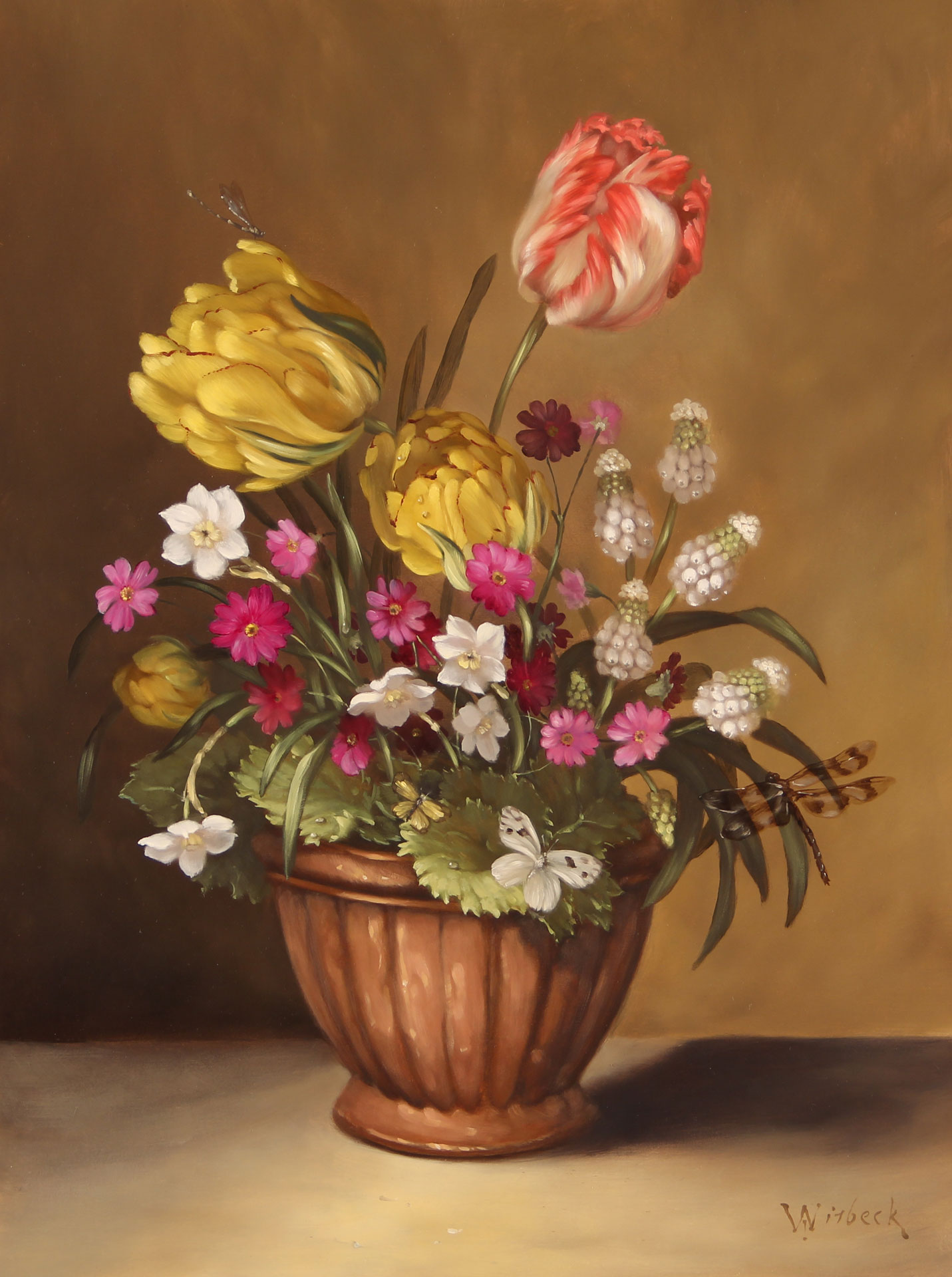W h i t b e c k N o t e s
Summer 2019

Orange and Silver
36"x 36" oil on canvas
Welcome to the Summer 2019 Whitbeck Notes
The blank canvas does not scare me. It has been said by others that just before starting a painting the stark white of a canvas can be a bit intimidating, and that making the first brush stroke is the hardest part of the whole process. For me it is one of the more energetic, with all the possibilities that lay before you. At this point in the painting your best work is about to start! I will admit that there can be a little sense of over whelming or a bit of trepidation, in that you are on your own and this thing grows only as a result of the movements of your hand. Wrong movements equal bad painting. Plus, the way in which I paint is very thought out and calculated. Not spontaneous. It is much like building a house, a metaphor which I have used before and find very fitting. The results of both come from pre-planned careful thought, and that if the foundation of your painting is out of whack, then the end picture will also be out of whack.
All of this is not to say that there are no bursts of artistic creativity, no artistic inspirations that can happen along the way, they sure do, it is just in a more controlled manner. And it has to be that way, it is a detail oriented, fine brush using technique. It seems to me that if you are painting what you truly love to paint, then it matches uncannily your own personality. Having participated in many art shows these past twelve years and having met many artists with many varying styles, I have personally found this to be true.

sketched layout of new still life
It is just a few light pencil marks that start it all off, placed just to give the general layout of the objects. It lets me know that everything stands in good relation to one another as far as height, width and the spaces in between.

monochromatic rendering
The next stage is a monochromatic rendering of the still life, usually done in a grayish or brownish wash. This thinned out oil paint starts to form up the edges of the objects in the painting and lays out the darks and lights and shadows. This stage is called the underpainting, the "foundation". At this point I sit back and take a good look. If something stands out, now is a good time to fix it. There is no color in this stage, but with all pretty well laid out you can get a good sense of the finished painting and if it is all going in the direction you had planned.

adding color
Dark to light, that is the basic idea. And in this next stage the colors start to come out. Trying to describe these stages is interesting, maybe this should be called the fitting, the basic coloring of life in the still life. No final adjustments yet, just a loose test of color. Simply put, the oranges are painted basic orange, the silver teapot is painted a grayish-silver, the figs purple and so on. These colors are "floating" over the monochromatic underpainting. There is not a lot of modeling going on yet and these layers of paint are thin, and like the previous underpainting stage, this goes rather quickly. This would be the framing up stage as far as the house building metaphor goes.

modeling of colors
Once these layers of paint are dry the real fun begins, a switching of gears happens and you start to slow down and become more thoughtful with your brush strokes. There is attention to the modeling of colors now and the characteristics of the objects start to show. One of my favorites is the surface of lemons and oranges. That shiny, bumpy texture of the skin. It is now that you start to work up and bring forth these qualities.

shadows
One of the beautiful aspects of this technique is its depth, part of which comes from the forms of darks and lights. Lit objects emerging from the dark, shadows as they angle across the table top, you can really get a sense of foreground and background. Part of this comes from treading lightly in the domain of shadows. Next time you are looking at one of my paintings look carefully at the shadows. See how thinly worked they are. As far as layers of paint go, there are but a few, translucently painted. And when the more opaquely painted light reaches around from the edge of a wine jug you can feel the merging of its heaviness into the shadows edges. These can be some of my favorite passages of a painting. Take a look at Titian or Tintoretto to get a great feel for these shadows and how they play such an important part in a paintings success.

building up
At this point in the painting we are going back over all of the objects, starting with the background and moving forward. Colors are becoming more intense, textures more pronounced and edges more defined. Parts of the painting are finished sooner then others. Those that want the most attention from the viewer demand more layers, thicker, more opaque, the last layer taking from the previous to stand out and shine. But part of the mystery of a painting can also be those pieces that hold off in the shadows of the background, or those that merge partially forward into the light. They require less attention then the rest, but they end up being just as important to the whole as the foreground objects. These, just like the shadows, are worked with less paint. It might sound that these would be easier to paint due to the less attention, but it is so easy to mess things up and get too heavy handed sometimes. To know when to stop can be just as important (and difficult) as knowing when to add one more brush stroke.
final tuning
If this is a medium sized painting and does not have too many objects, we are about two weeks into it. I am not working on this painting eight hours a day, seven days a week, but instead a few hours a day, each day. Because the basic build-up of the painting is in layers and each layer must dry before you continue, you are forced to set it aside and come back to it the next day or even the day after. So in this manner of painting and waiting, painting and waiting the time can add up.
These next few stages of the painting become more rewarding as you continue on, tweaking here and there, lightening this, darkening that, blurring this edge or sharpening that one. There is a lot of standing back from the easel to get a different perspective, and even turning the painting upside down to trick your eye in seeing things fresh. Funny, but it works.

final details
To me, the painting does not truly come to life until those final high-lights are brought to the canvas. They are the sparkle in the eye. Yes, this is a good comparison. A sparkle, a shine, a gleam. This is where the life is. Those final high-lights and reflections are what animate these still objects. And this is a tricky part because it is so easy to get it wrong. It is not as easy as a plunk of paint on an orange peel. It either works or it doesn't. If it does not, you have to wipe it away and try again. Frustration would be a good description for this. But this stage is so important, and getting it right is crucial.
Some of my best lessons have come from visiting museums and getting close to an original to view the artists brush strokes. Not much can be learned, in this respect, from a good print in a book or even viewing from a distance. You have to approach and see the dabs of paint alone, singled out, and then study and figure it out. The high-lights on a worn, scratched silver vase are applied differently then then those on one in a smooth, good condition. What are the differences in the brush strokes, how did they apply them. Get close and look! It is so exciting to return back to my studio after such a visit and try out my newly acquired knowledge, putting it all into practice.
After a few days of working on these high-lights as well as some of the final adjusting here and there, we can finally, with a little hemming and hawing and dragging of feet say that the painting is done. It will now spend the next couple of weeks drying before the first coat of varnish is applied. Those thick dabs of pure white high-lights take FOREVER to dry! But when they do and the first varnish is brushed on, it is like magic. The richness and vibrancy of the colors pop and all of the sunken brown umbers are re-enlivened with saturation. Think of it like one of those beautiful beach stones that have dried out in the baking sun, dull and lackluster in color, but when dipped in the oceans waves it is now a gem, a ruby, a sapphire! Two coats of varnish will accomplish this very satisfying step.
Such a description does not do justice to the labor put into a painting using this technique, but one can get an idea of it's basic steps and form an idea of what it takes to complete a painting in this traditional manner. And one can see too the great difference there is in this painting style as opposed to painting in the more loose, spontaneous way with the abstract and impressionist painters. Also there is a bit of a difference in the way that I paint my "Flemish Floral's". But that will have to wait for another Whitbeck Notes. And know too that the white of a canvas does not have to be so intimidating.


Key Limes and Fruit
12" x 16" oil on panel
Spring Bouquet
16" x 12" oil on panel
With a fantastic mid-west art show tour behind me, I now look forward to getting back in the studio and getting to work on some new paintings, as well as looking forward to my summer and fall art shows. Take a look at the schedule on my website www.jameswhitbeck.com to see what's coming up.
All my best,
James Whitbeck
(413)-695-3937
A brief description of technique